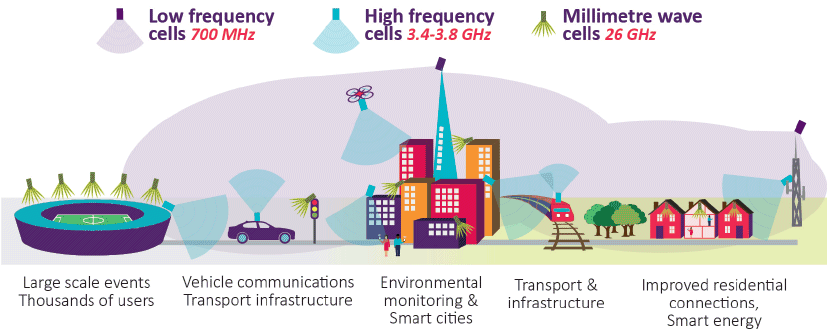Ofcom Consults on UK Use of 26GHz and 3.6-3.8GHz for Future 5G Mobile
The UK telecoms regulator has launched a Call for Inputs that seeks feedback on their proposal to harness the 26GHz radio spectrum band for future 5G based fixed wireless and Mobile Broadband technologies. Ofcom has also confirmed their intention to use the 3.6GHz to 3.8GHz band.
Ofcom has previously short-listed a number of radio spectrum bands (700MHz, 3.4-3.8GHz and the higher frequency 24.25-27.5GHz) for future use by 5G communication technologies (here) and most of those are already going through the full consultation phase. A second consultation published today also sets out their proposed approach for the 3.6GHz to 3.8GHz band (here).
The proposed approach would enable future mobile services in the 3.6GHz to 3.8GHz band to be deployed in many areas from around 2020, and nationwide by 2022. The regulator added that they were “minded to award this spectrum in 2019, combined with 700MHz spectrum,” although they added that “there are many areas in which these frequencies could be used from today, for trials and pre-commercial deployments.”
Advertisement
In this approach 700MHz would be useful for cheaply delivering wide 5G Mobile coverage in rural areas, albeit at slower speeds. Meanwhile the higher frequencies above 24GHz (e.g. millimetre Wave) will support “very large bandwidths, providing ultra-high capacity and very low latency“, although their limited range will confine their use to areas of high demand (i.e. cities) and fixed wireless links.

However the regulator are also looking at the prospect of harnessing a mass of other bands for 5G connectivity, with today’s ‘Call for Inputs’ focusing upon the desired 26GHz band, which covers 3.25GHz worth of radio spectrum between 24.25GHz and 27.5GHz.
The “upper” 26GHz band (26.5 – 27.5GHz) is currently used by the Ministry of Defence (MoD), albeit “extremely lightly” and is therefore available for deployment of 5G. Meanwhile the “lower” 26GHz band (24.25 – 26.5GHz) is managed and assigned by Ofcom, which has allowed various services to use it including fixed links, Satellite receiver Earth stations, Programme Making and Special Event stations (PMSE) and Short Range Devices (SRDs).
Advertisement
The regulator is undertaking a programme of work to make the whole of the 26GHz band available for 5G on a progressive basis, with an initial focus on the “upper” 1GHz of the band, given its light use. Many of the early 5G trials, including the one launched by Arqiva in London this week (here), have made use of the nearby 28GHz band for ultrafast fixed wireless broadband links and so 26GHz is a good place to target.
On top of that Ofcom has today also said that they’re now promoting 66 – 71GHz as another priority band for 5G and they believe that 40.5 – 43.5GHz should similarly be identified as a priority band. On top of that they suggest that “a tuning range covering the frequency range 37 – 43.5GHz has strong potential to become a 5G band for harmonisation of equipment.” Various other bands are also being considered.
Today’s Call for Inputs will remain open for feedback until 5pm on 22nd September 2017.
Mark is a professional technology writer, IT consultant and computer engineer from Dorset (England), he also founded ISPreview in 1999 and enjoys analysing the latest telecoms and broadband developments. Find me on X (Twitter), Mastodon, Facebook, BlueSky, Threads.net and Linkedin.
« Satellite ISP SSW Gobbles UK Fixed Wireless Broadband Provider Quickline


















































Comments are closed